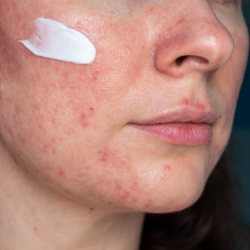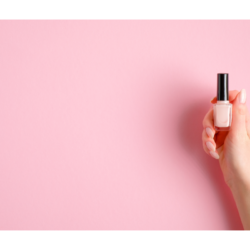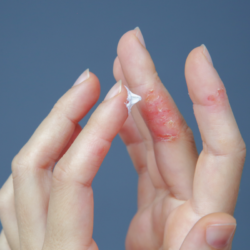Eczema is actually the name of a group of conditions that cause different symptoms: inflammation, itching and a reddening of the skin. Otherwise known as atopic dermatitiseczema is not contagious. Although the exact cause of eczema is unknown, researchers know that people who develop it do so because ofa combination of genes and environmental triggers.
@soin.et.nature ✨️D’après une étude Ifop Sanofi Genzyme, un Français sur trois (34%) a déjà été affecté par de l’eczéma au cours de sa vie, ce qui en ferait d’après cette enquête, la troisième maladie chronique de peau la plus répandue en France après l’acné (59%) et les mycoses (43%) ✨️Retrouvez les produits de cette routine peau sur notre site, lien dans la bio 👉⭐️✨️Dites moi en commentaire quelle est votre routine en cas de poussée d’eczema ?#dermatologie #pourtoi #cosmétiques #skintok #perpignan #peau #cicatrices #peauatopique #conseilsbeaute #frenchpharmacie #frenchpharmacy #rougeurs #eczema #atopicdermatitiswarrior #peausaine#bellepeau#conseilpeau #peauseche #fyp #foryou#viral #relachement #peausensible #barrierecutanee #acidehyaluronique #glycerine #visage #psoriasis #ceramides #ceramidesbycerave #larocheposay #sansparfum#conseilgratuit #astuce #acne #boutons #dermatips #dermatite #astucepeau#routinepeau #produits #produitsdebeautés #routinepeau #astucepeau
What is eczema and what are its causes and triggers?
Atopic dermatitis is a chronic disease. It is characterised by itching, impaired skin barrier function and sensitisation to food and environmental allergens. Because it results from interactions between genes and the environment, atopic dermatitis is a complex disease.
There are three classic stages of eczema: infancy, childhood and adulthood. The spectrum of eczema presentation is highly variable, ranging from a variant that only affects the hand to major forms where the patient presents with erythroderma. The acute and sub-acute lesions of atopic dermatitis are often characterised by intensely pruritic erythematous papules and vesicles. Patients suffering from atopic dermatitis are also more exposed to skin infections, particularly bacterial and viral superinfections (overpopulation of Staphylococcus aureus (S. aureus))
Some causes and triggers:
In short, in people with eczema, the skin barrier does not provide sufficient protection. The stratum corneum is undeniably damaged by a strong inflammatory response. Another possible cause is a mutated gene that affects the production of the protein filaggrin , which the body needs to make the outer layer of the skin. Because there isn’t enough filaggrin, the balance of lipids in the skin changes. This leads to a significant loss of moisture. A compromised skin barrier also offers less protection against irritants, allergens (substances that can trigger allergies) and germs that can cause infections.
What’s more, around 30-40% of eczema sufferers are allergic. Their immune system reacts to allergens by releasing antibodies. This causes inflammation.
It should be noted that the skin can also be irritated by environmental factors or other substances that are not allergens. These include rough fabrics that come into contact with the skin, such as wool, cigarette smoke and extreme temperatures.
What are the different types of eczema?
Eczema, also known as dermatitis, is an inflammatory skin condition characterised by itching, redness and rashes. The condition can affect people of all ages and manifests itself in several distinct forms. Recognising the different types of eczema is essential to understanding the causes and appropriate treatments. Here is a detailed overview of the main forms of eczema.
Atopic eczema
Atopic eczema is the most common form, often referred to simply as ‘eczema’. Usually diagnosed in childhood, this type has a strong genetic component and is frequently associated with other atopic conditions such as asthma and allergic rhinitis. Symptoms include dry skin, intense itching and rashes on the face, neck, elbows and behind the knees.
Contact eczema
Contact eczema occurs when the skin reacts to an allergen or irritant. It falls into two categories: allergic contact eczema and irritant contact eczema. Manifestations include redness, burning and itching at the site of contact with the allergen or irritant.
Dyshidrotic eczema
Dyshidrotic eczema, or dyshidrosis, mainly affects the palms of the hands, the sides of the fingers and the soles of the feet. Characterised by fluid-filled vesicles or bubbles, this type of eczema can be painful and is often associated with itching and burning.
Nummular eczema
Also known as nummular dermatitis because of its round or oval patches resembling coins, nummular eczema is characterised by distinct skin lesions, often oozing or crusting. This may be the result of dry skin, a reaction to inflammation or a skin infection.
Seborrhoeic eczema
Seborrhoeic eczema is often linked to inflammation of the skin affected by seborrhoea, an excessive production of sebum. Areas usually affected include the scalp, eyebrows, wings of the nose and other parts of the body where sebaceous glands are present in large numbers. Symptoms include scaly patches, oily skin and redness.
Atopic dermatitis
Atopic dermatitis is a chronic form of eczema that alternates between flare-ups and remissions. It is similar to atopic eczema and often includes very dry skin, erythematous patches and itching.
Varicose eczema
Varicose eczema, also known as venous eczema, often develops in the context of circulation disorders, particularly in the legs. Symptoms include itching, thickening of the skin and pigmentation.
Is eczema contagious?
No, eczema is not contagious. Eczema, also known as atopic dermatitis, is a chronic skin condition characterised by dry, itchy skin and inflammatory rashes. It is caused by a combination of genetic and environmental factors that affect the skin barrier and the immune system, but it cannot be transmitted from one person to another through contact. Eczema triggers can vary from person to person and include allergens, irritants, temperature changes and stress. It is important to understand the mechanisms and triggers of the condition in order to manage symptoms effectively.
Can diet influence eczema?
The influence of diet on eczema is a growing area of interest for many people with this skin condition. Research suggests that there may be a correlation between eating habits and the intensity of eczema symptoms.
A balanced diet rich in fruit and vegetables can help maintain healthy skin and reduce inflammation, a key symptom of eczema. Certain foods have natural anti-inflammatory properties, such as oily fish rich in omega-3, linseed and walnuts. It is also advisable to incorporate probiotic-rich foods such as yoghurt or fermented foods, as they can support the health of the intestinal flora, which plays a role in the immune system and can affect eczema.
It is also known that certain foods can exacerbate eczema symptoms in sensitive individuals. These foods include, but are not limited to, dairy products, foods high in refined sugar, refined carbohydrates and certain food additives. Keeping a food diary is recommended to help identify possible trigger foods.
However, it is essential to note that each person is unique, and food triggers can vary considerably. Before making any significant changes to your diet, it’s a good idea to consult a healthcare professional, such as a dietician or doctor, who can provide personalised advice.
How can eczema flare-ups be prevented?
Preventing eczema flare-ups involves taking proactive steps to maintain the skin barrier and minimise exposure to triggers. The following strategies can be effective in reducing the frequency and severity of eczema flare-ups:
- Moisturising the skin: Apply moisturising creams daily, especially after showering, to restore moisture to the skin and strengthen the skin barrier.
- Lukewarm showers and baths: Choose lukewarm rather than hot showers or baths, and limit them to 10-15 minutes to avoid drying out the skin.
- Choice of skincare products: Use mild soaps and soap-free cleansers and avoid products containing perfumes, dyes or preservatives that can irritate the skin.
- Stress management: Since stress can trigger or exacerbate eczema, relaxation techniques such as meditation, yoga or breathing exercises can be beneficial.
- Appropriate clothing: Wear clothes made from natural fabrics such as cotton, which are less likely to irritate the skin than synthetic fabrics or wool.
- Environmental control: Maintain a clean home environment to reduce the presence of dust mites and mould, and use a humidifier if the air is too dry.
- Diet: As mentioned above, identify and avoid foods that may trigger or aggravate your eczema.
- Follow medical treatment: Follow your healthcare professional’s prescriptions and advice and discuss any necessary treatment adjustments.
- Identifying triggers: Be aware of individual triggers and try to avoid them as much as possible.
Preventing eczema flare-ups is a personalised and dynamic process that may require adapting these recommendations according to individual reactions. Regular communication with a healthcare professional is crucial to successful prevention.
Can eczema disappear with age?
The course of eczema, scientifically known as atopic dermatitis, varies significantly from one individual to another. In many cases, children with eczema see their symptoms diminish or disappear with age. However, it is also possible for eczema to persist into adulthood.
Studies show that up to around 60% of children with moderate to severe eczema symptoms may continue to show signs of the condition into adulthood. In some individuals, the condition may improve during adolescence, only to reappear later in life due to certain triggers, such as stress or environmental irritants.
While there is no definitive cure for eczema, effective symptom management is possible. Topical treatments, lifestyle adjustments, and flare prevention strategies can help control the condition, reducing its impact on the quality of life of those affected.
It is essential to consult a healthcare professional for an accurate diagnosis and a suitable treatment plan. Regular medical follow-up can help monitor the progress of the disease and adjust treatment if necessary.
How do I know what “my” eczema triggers are?
To identify your personal eczema triggers, it’s best to follow a systematic, organised approach. Here are the key steps to consider:
- Keeping a diary: Keep a daily record of your activities, your diet, the products you use and the condition of your skin. Include environmental variations such as climate and stress levels.
- Medical evaluation: Consult a healthcare professional to assess whether allergy tests or additional examinations are necessary to detect specific allergens.
- Allergen testing: Under the guidance of an allergist, skin or blood tests may be carried out to identify potential allergens.
- Exclusion and reintroduction: In consultation with a health professional, eliminate certain suspected foods or products for a set period, then reintroduce them one by one to observe reactions.
- Be careful with products: Be vigilant about personal care and household products, as they may contain irritants or allergens.
- Observing reactions: Note any reactions after contact with new products, clothing or animals.
- Analysis of environmental conditions: Examine the influence of environmental conditions such as dust, pollen, mould or extreme temperatures.
- Stress management: Assess the impact of stress on your eczema and explore relaxation techniques to minimise it.
Identifying triggers is a personalised process that can take time and patience. Close collaboration with healthcare professionals is essential for an accurate assessment and to put in place a management plan tailored to each individual.
Is the skin microbiota of a person with eczema different?
The microbiota, particularly the skin microbiota, of a person with eczema often has distinct characteristics compared with that of a person with healthy skin. Research indicates changes in the composition and diversity of micro-organisms present on the skin of individuals with eczema. These changes can influence inflammation and the skin barrier, playing a role in the symptoms associated with eczema.
Studies have shown an increase in the colonisation of pathogenic bacteria, such as Staphylococcus aureus, on the skin of eczema sufferers, which can exacerbate inflammatory symptoms. In addition, a reduction in bacterial diversity in the skin microbiota may alter the skin’s protective functions, contributing to susceptibility to infection and inflammation. (1)
It should also be noted that the intestinal microbiota plays a role in the development and regulation of the immune system. Imbalances in the intestinal microbiota, known as dysbiosis, can be associated with inflammatory skin disorders such as eczema.
These findings suggest that modulating the microbiota through targeted interventions, such as the use of probiotics or prebiotics, could represent a complementary therapeutic avenue in the management of eczema. However, further research is needed to better understand the underlying mechanisms and to develop effective therapeutic strategies based on the microbiota.
What is the naturopath’s opinion?
Naturopaths consider eczema to be a “valve” disease. In short, an overworked body eliminates “toxins” of intestinal origin through the skin.
According to Naturopath Robert Masson, the causes of eczema are as follows:
- Nibbling
- Eating fruit with meals
- Consumption of dairy proteins of bovine origin
- Stress
- Omega-3 deficiency
- Digestive problems
Despite the uncertain links between diet and eczema, it is vital to look after your diet and digestion. In short, you need to respect the digestion time between meals. Eating too many or too frequent meals can overload the body’s digestive and metabolic systems. This could lead to the “release” of “toxins” through the skin.
My list of anti-eczema remedies at Soin-&-Nature
Indeed, conventional eczema treatment includesavoiding irritants and potential allergens. Secondly, it is advisable to moisturise the skin twice a day with emollients such as glycerine. In fact, topical corticosteroids and topical immunomodulators are often used in the first instance. However, other therapies such as phototherapy, antimicrobials, antihistamines and systemic immunosuppressants can also be considered in certain situations.
Basic treatment of atopic dermatitis
Ultimately, to prevent the skin from drying out, care should be taken toapply lipid-replenishing and moisturising (emollient)products at least twice a day. This helps to relieve itching and protect the skin from germs and irritants.
- Glycerine
- Bioderma Atoderm Intensive Gel Cream
Special soaps, liquid cleansers and shampoos
Normal soaps and products such as shampoos or shower gels contain various substances that can dry out the skin. However, there are cleansing products specially designed for eczema sufferers.
Steroid creams and balms
Ultimately, steroid creams are generally the treatment of choice for calming acute attacks. These creams can quickly relieve itching and inflammation.
Food supplements to soothe your eczema on a daily basis
Eczema is a common skin condition that can cause itching, irritation and redness. There are several types of treatments that can help reduce the symptoms of eczema and promote healing. We’ll show you some natural treatment options to help you achieve a full recovery.
- Pileje anti-inflammatory probiotics are dietary supplements that promote balanced intestinal flora and help reduce inflammation. They can benefit eczema sufferers by helping to relieve inflammatory symptoms.
- Neurogenius Stress out is a dietary supplement designed to help combat stress and anxiety. As stress can worsen eczema symptoms, this product may be useful for sufferers of this skin condition.
- Magnesium is an essential mineral for skin health. It helps to reduce inflammation and promote skin repair. Taking a magnesium supplement can help relieve the symptoms of eczema.
- Omega-3 fatty acids are essential nutrients with anti-inflammatory properties. They can help reduce the inflammation associated with eczema and improve overall skin health.
- Sea Buckthorn is a plant rich in vitamins, minerals and essential fatty acids. It can help boost the immune system, reduce inflammation and promote skin healing in eczema sufferers.
- Linden sapwood is a plant that helps to drain and purify the body. By eliminating toxins, it can help improve skin health and reduce eczema symptoms.
- Overwork can aggravate the symptoms of atopic dermatitis. Stabilium Yalacta is a dietary supplement that helps combat fatigue and stress, promoting better balance and better management of the symptoms of this dermatitis.
In conclusion, there are many natural food supplements and methods to help treat and relieve the symptoms of dermatological pathology.
Gemmotherapy: the benefits of plant glycerol macerates
Gemmotherapy is a treatment method that uses products obtained by macerating the embryonic parts of plants. Buds, young shoots and rootlets are macerated in a mixture of water, alcohol and glycerine to obtain a glycerine macerate with beneficial health properties.
Plant glycerine macerates are used pure or diluted, usually to one-tenth (1D). They are particularly interesting because they can be used on children aged 30 months and over. For optimum effectiveness, it is recommended that you take the drops of glycerol macerate in the middle of a meal, as a 3-week course of treatment with a one-week break, preferably for a minimum of 3 months. Plant glycerol macerates can also be taken as a maintenance treatment, one week a month.
- Herbalgem bud complex for detoxification is a blend of plants which help to eliminate toxins from the body. This dietary supplement can help purify the body and reduce eczema symptoms by promoting the elimination of irritating substances.
- The bud complex to relieve skin pain and inflammation is a blend of plants which acts directly on the skin. This supplement can help reduce the redness, itching and irritation associated with eczema.
- Blackcurrant buds (Ribes nigrum MG1D) are particularly recommended for their anti-inflammatory and immunostimulant action. They can be used in adults at a dose of 50 to 100 drops per day in the form of 1D glycerol macerate, to be diluted in water. For children, the dosage is one drop per kilogram per day. Blackcurrant buds should preferably be taken in the morning, as they have an adrenocortical stimulating effect, similar to that of cortisone.
- Cedar of Lebanon buds (Cedrus libani MG 1D) are particularly useful for dry eczema. For optimum effectiveness, we recommend taking 100 drops morning, noon and night with a large glass of water and a meal.
- Elm bud is a plant known for its beneficial properties for the skin. It can help soothe skin irritations, reduce redness and promote healing in eczema sufferers.
In conclusion, gemmotherapy is a natural care method that uses the beneficial properties of plants to treat a wide range of ailments. Glycerine macerates of plants such as blackcurrant and Lebanese cedar buds can be used safely in children aged 30 months and over, and are a natural alternative to traditional medicines. However, it is important to follow the recommended dosage for optimum effectiveness.
Specific skin care products to soothe eczema
- Atoderm cream-gel is an emollient skin care product designed to moisturise and soothe dry, irritated skin. It can be used daily to help relieve the symptoms of this skin condition.
- Atoderm Intensive is a specific eye care product which soothes and moisturises the sensitive skin around the eyes. It is particularly recommended for people suffering from eyelid eczema.
- The La Roche-Posay Eczéma Med medical device is designed to treat and relieve the symptoms of eczema. It helps repair the skin barrier and reduce redness and itching.
- Dexyane is a skin care product specially formulated foreczema of the eyelids. It soothes and moisturises the skin while reducing redness and irritation.
- Dermalex cream is specifically designed to soothe and treat hand irritation caused by eczema. Its moisturising and protective formula helps relieve itching and redness.
- Ducray Med Soothing Repair Cream is designed for skin prone to eczema. It helps repair and strengthen the skin barrier while soothing irritation and itching.
- Stelatopia intense soothing cream is specially formulated for sensitive skin irritated by eczema. It moisturises, nourishes and soothes irritation, helping to reduce the most troublesome symptoms.
- Stelatopia Emollient Balm is a moisturising and nourishing treatment that soothes dry, irritated skin. It is particularly recommended for people suffering from atopic dermatitis, as it helps to restore the skin barrier and relieve itching.
- Shea butter is a natural moisturiser rich in vitamins and essential fatty acids that nourishes and protects the skin. It can be used to soothe and repair skin irritated by eczema, while reducing redness and the urge to scratch.
Sources
- Richard MA et al. J Eur Acad Dermatol Venereol. 2018 Nov;32(11):1967-1971
- (1) https://www.ncbi.nlm.nih.gov/pmc/articles/PMC8998607/
- Barbarot S et al. Allergy. 2018;73:1284-1293
- https://www.ncbi.nlm.nih.gov/books/NBK538209/
- https://pubmed.ncbi.nlm.nih.gov/21913202/
- https://pubmed.ncbi.nlm.nih.gov/25958949/
- https://pubmed.ncbi.nlm.nih.gov/32083522/
- Diététique de l’expérience, Robert Masson







